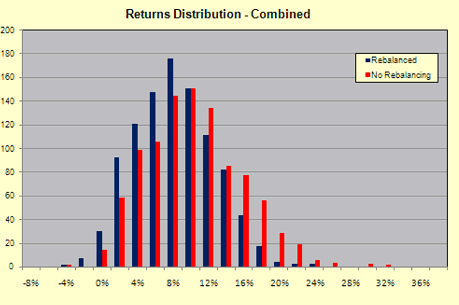Optimal Rebalancing Frequency
Post on: 3 Июнь, 2015 No Comment

Is there a preferred frequency and are there preferred month(s) for rebalancing traditional asset class portfolio holdings? To investigate we consider annual, semiannual and quarterly rebalancing of a simple portfolio targeting a 60-40 stocks-bonds mix. We consider all possible combinations of calendar month ends as rebalancing points. Because of estimation complexity, we ignore rebalancing (and dividend-reinvestment) frictions, thereby giving an an advantage to frequent rebalancing. Using dividend-adjusted monthly closes for SPDR S&P 500 (SPY) to represent stocks and Vanguard Total Bond Market Index (VBMFX) to represent bonds over the period January 1993 through December 2011 (228 months or 19 years), we find that:
The following three charts summarize average gross monthly returns and variability of gross monthly returns for three sets of alternatives for rebalancing a SPY-VBMFX portfolio to a 60-40 ratio over the available sample period, in order:
Top chart: Annual rebalancing at the end of each of the 12 calendar months (18-19 rebalances).
Middle chart: Six combinations of semiannual rebalancing at the ends of paired calendar months (37-38 rebalances).
Bottom chart: Three combinations of quarterly rebalancing at the ends of associated groups of four calendar months (75-76 rebalances).
Each chart includes comparable data for SPY, VBMFX and monthly rebalancing of a SPY-VBMFX portfolio to a 60-40 ratio.
Differences in average monthly returns and variability ranges across rebalancing alternatives are very small and may be strictly random. The average gross monthly returns across annual, semiannual and quarterly combinations are 0.64%, 0.64% and 0.63%, respectively. Corresponding average standard deviations of gross monthly returns are 2.65%, 2.64% and 2.69%, respectively. There is no penalty for choosing annual rebalancing to avoid frequent rebalancing frictions.
For a different perspective, we compare terminal values of $100,000 initial investments.
The next three charts summarize gross terminal values of $100,000 initial investments at the end of January 1993 for the same three sets of alternatives for rebalancing of a SPY-VBMFX portfolio to a 60-40 ratio over the available sample period. Each chart includes comparable terminal values for buying and holding SPY, buying and holding VBMFX and monthly rebalancing of a SPY-VBMFX portfolio to a 60-40 ratio.
Differences in terminal values among alternatives are very small and may be strictly random.
The average gross terminal values across annual, semiannual and quarterly combinations are $393,184, $390,538 and $386,542, respectively. Again, there is no penalty for choosing annual rebalancing to avoid frequent rebalancing frictions.
In summary, evidence from simple tests on a basic stocks-bonds portfolio with 60-40 target ratio indicates that it makes no gross difference which months an investor chooses for rebalancing or whether rebalancing is annual, semiannual or quarterly.
In this case, annual rebalancing has the advantage of lowest trading frictions.
Cautions regarding findings include:
- More generally, the optimal rebalancing frequency derives from a trade-off between how an investing/trading strategy generates outperformance and how much it costs to rebalance. The optimal frequency may be high (low) for fast-moving (slow-moving) strategies. See Use Short-term Signals to Inform Rebalancing? .
- Also, percentage trading friction is higher for small accounts than large accounts, affecting the optimal rebalancing frequency.
- Including more asset classes in the portfolio would increase rebalancing costs, thereby likely favoring lower rebalancing frequency.
Note that findings in Mirror Image Seasonality for Stocks and Treasuries? suggest that seasonal effects for stocks and bonds may tend to offset.
Why not subscribe to our premium content?
It costs less than a single trading commission. Learn more here.














